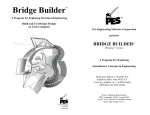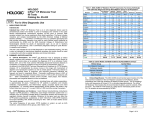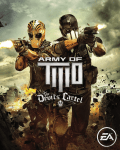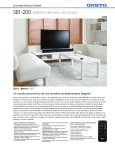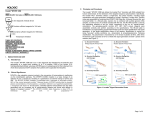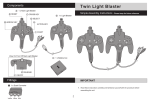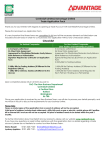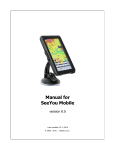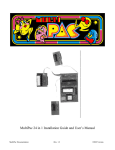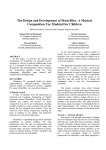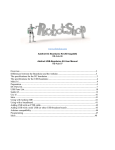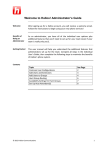Download our Testing Manual
Transcript
Tau Paper Prototype Guidelines Prepared for: Jeremy Cooperstock, ECE689 Prepared by: Andrew Hankinson, Jessica Ip, Wei Zhong Li, Gaurav Namit February 12, 2009 [email protected] http://coltrane.music.mcgill.ca/hci Table of Contents User Materials 3 Purpose 3 User Introduction 4 Pre-Test Questionnaire 5 Consent Form 7 User Manual 8 Tasks—One Player 11 Tasks—Two Player 13 Testing Materials 15 Purpose 15 Observation Briefing 16 Test Script 17 Benchmarks 18 Data Collection Sheet 20 Post-test Questionnaire 23 Tau Paper Prototype Guidelines i User Materials Purpose The following pages contain materials used for performing paper prototype user testing. These are the materials that will be presented to the test subjects themselves. You will find materials to be used by the testing team in the next section, Testing Materials. Tau Paper Prototype Guidelines 1 User Introduction Welcome! Today you will be participating in a study for an interactive board game called tau, our new board game based on classic tower defence games, but with some interesting twists. The focus is to study how users interact with the new features and interactive play modes we are developing. Purpose Using the tools and system provided, you will be asked to play several "levels" of a tower defence game on our interactive board game interface. You will be provided several tiles marked with different patterns on them; each distinct pattern has a specific meaning in the game. The game itself will be projected onto a table surface, which is where you will place the tiles once the game begins. Gameplay At the beginning of the test you will be informed about the game play. You will be given a very short user manual which will specify how the gameplay works, and how the components of the game are used. Today we will be evaluating a paper-based prototype of the system. While you proceed through the test tasks, we will be playing puppeteer with the interface, simulating a live environment by moving and animating the components of the gameplay by hand. It will not be as fast-paced as our final version, but it will allow us to work out some of our bigger kinks early on. Observation When the experiment begins, we will be watching and recording your interaction with the system. This may feel a bit weird, but we’re mostly harmless. Our cameras will be recording sound as well, so if you have a thought just say it out loud and our team of analysts and engineers will be able to refer back to your comments. If you are confused at any time, we also want to know! Your skill level or comprehension is not being tested; rather, you’re testing us to see if we’ve really thought this through. Any recorded data is confidential and will only be used for the purposes of improving our game. And so, we welcome you to the world of tau. We hope you enjoy playing it as much as we’ve enjoyed making it. Tau Paper Prototype Guidelines 2 Pre-Test Questionnaire 1. How much experience do you have with tower defense games? a. b. c. d. 2. If you have experience with tower defense games, what types have you played? Circle all that apply. a. b. c. d. e. 3. Wii remote/Nunchuck Other Wii accessories (yoga mat, steering wheel, etc) Rockband drumming interface Rockband/Guitar Hero guitar interface Nintendo DS stylus Other: _________________ If you've used at least one of the above gaming interfaces, how difficult was it to learn to use the device itself, without considering game difficulty? a. b. c. d. e. 7. Rarely Several times a month Once to several times a week Every day. Have you used any of the following gaming interfaces? Circle all that apply. a. b. c. d. e. f. 6. Rarely Once or twice a month One a week Several times a week How often do you play video games? a. b. c. d. 5. Set path for monsters, towers built around path. Towers make path for monsters to walk. Co-op towers working with other teammate(s) in some way. Competitive towers working against other players. Other: _____________ How often do you play board games (including online versions)? a. b. c. d. 4. None Played 1-10 full games Played 10-40 full games Played 40+ full games Very easy Somewhat easy Moderate A little difficult Very difficult Did you enjoy using those gaming interfaces? 1. 2. 3. 4. 5. Not at all A little bit Somewhat Fairly enjoyable Very enjoyable Tau Paper Prototype Guidelines 3 Do you have any comments about the gaming interfaces you used, as mentioned above? Tau Paper Prototype Guidelines 4 Consent Form I, _____________________________________________, agree to be a participant in the paper prototype testing for tau. I will try my best to provide as much feedback as possible for the observers and evaluators. I understand that this is an evaluation of the interface and not my personal skill. Signed: __________________________________________________ Date: _______________________ Tau Paper Prototype Guidelines 5 User Manual Overview Your tau game board is a projected map containing a divided playing surface, a path, a control area and a status area. The object of the game is to place special markers on your side of the board, representing defence towers, to prevent invaders from making their way through the path from the entrance to the exit. Tau will recognize special patterns on these blocks and will place one of four different types of towers in the marker’s location. control Team-mateʼs tower status Entrance Exit Your playing area Your tower Figure 1: The tau Playing Field Your side of the board is always the side opposite the control and status areas. Since this is networked play, your remote team-mate will have control of the side of the board opposite yours, and their towers will appear on that side. While play is co-operative against the invaders, it is also competitive between players. Each invader eliminated by a player’s tower earns them 1 point, and these points may be used to buy new towers to put on the board. The player at the end of the game with the most assets (towers and points combined) will be declared ‘most valuable player.’ Play proceeds through rounds, with each round presenting a tougher challenge than the previous. Invaders increase in number and strength through the rounds, and you and your team-mate must proceed successfully through 20 rounds. You start the game with 20 lives. Each invader that successfully makes it through the path causes you and your teammate to lose one life. You will both lose the game when you have no more lives left. Tau Paper Prototype Guidelines 6 Play is controlled by using special game card markers placed in the control area. These markers represent actions that a player wishes take in the game. They include: • A play card: This marker controls the player’s abilities to play or pause the game. When the play card is in the control area, the game is on. Removing this card from the control area will pause the game for both players. • A build-mode card: Placing this marker on top of the play marker sends a request to the other player to enter into build mode, who agrees by placing their build mode card in the status area. In this mode, the game is paused and players can place their towers. Removing the build-mode card alerts the remote player that you are ready to play, and the game proceeds when they remove their card. • A new game card: Placing this marker on top of the play marker sends a request for starting a new game, which the other player must agree to by placing their new game card on the control area as well. Gameplay You and your team-mate begin with 30 credits to use towards placing towers. The game begins by requesting that both players place their build-mode cards in the control area. Build Mode & Placing Towers When in build mode, towers may be placed everywhere on your side of the field outside of the path. If you attempt to place a tower on the path or on your team-mate’s side, your tower will be highlighted red and it will not be active on the board. Likewise, if you attempt to place a tower and do not have the appropriate number of points, your tower will be highlighted red and will not be active against the invaders. When placing towers, a translucent circle will appear around the tower in build mode, outlining the effective shooting radius of that tower. When you are satisfied with your tower placement, remove your build mode card from the control area. This will alert your team-mate that you are ready to play, and prompt them to remove their build mode card. You may re-enter build mode at any point in the game, but it must be mutually agreed upon by both players. When a build mode request is made by one player, the other player will be alerted and asked to respond. When they place their build mode card in the command area, the game pauses and enters build mode. If, after 10 seconds, a response is not received, the game play will continue but both players will not earn points for any invaders eliminated. To resolve this, either the player requesting the build mode removes their request, or the other player agrees to the request. Your points determine how many towers you can place in build mode. There are four different types of towers, each with unique abilities and costs. • Regular towers, costs 15 credits: This is your defensive workhorse. These towers are not overly fast or effective, but they are cheap and provide a constant barrage against the invaders. Tau Paper Prototype Guidelines 7 • Glue towers, costs 8 credits: These cause no damage to the invaders, but will slow them down to give your towers more time to attack. • Cannon towers, costs 20 credits: These cause more damage than regular towers, but fire slower. Using them in cooperation with glue towers is probably a good idea. • Wizard towers, costs 40 credits: Fast and damaging, these are also very expensive. Use them to augment your defences in particularly effective locations, but do not try to save up to cover your field with them: you will lose the game before you do. Invasion The invaders will enter the screen and attempt to make their way through the path to the exit. For each invader that your towers eliminate, you will earn one point; likewise, your team-mate will earn a point for each invader they eliminate. At the end of the round you will be given five seconds to place your build cards in the control area. If you are satisfied with your tower placement, simply wait for the clock to count down. If you are not, place your build card in the control area. Each round features an increasing amount of invaders, and each invader becomes harder to eliminate. Working with your team-mate to cover particular choke points is good strategy. Game Controls The game may be paused at any time. You may initiating a pause by removing the ‘play’ card from the control area. This will pause the game for both players. To return to the game, replace the ‘play’ card in the command area. To start a new game and reset all scores and points, a player places their ‘new game’ card on the control area, and the game alerts the other player that this request has been made. If the other player responds by also placing their ‘new game’ card, the game is reset and the players start again at level 1 with their default points and lives. Winning and Losing If you have reached the end of the game, congratulations! You and your team-mate’s points will be tallied, and the player with the most assets will be declared ‘most valuable player.’ Assets are tallied as: 1 point for every un-spent invader elimination points, 2 points for every regular tower on the playing field, 0 points for every glue tower on the playing field, 5 points for every cannon tower on the playing field, and 10 points for every wizard tower on the playing field. If, however, you have reached the end of the game by allowing too many invaders to cross the field, that’s too bad! Hopefully in your game you have gained insights into more effective tower placement strategies and ways in which you and your team-mate can co-operate. Tau Paper Prototype Guidelines 8 Tasks—One Player Task One In front of you is the game board for our tower defense game dedicated to usability testing. Study the game board without putting anything down and comment on the following: 1. 2. 3. 4. Please give me your initial impression about the layout, what certain components are for, etc. Please describe the options you see on the board and what you think they do. If you were exploring, what would you do first? What do you think the purpose of the board is? Task Two Explore the board. I am going to give you some time to freely explore the game. You may put any tile at any location of the play board to see what kind of feedback the system will give you. Please wait for instructions before proceeding to task three. Task Three Start a new game. You are asked to start a new game in the middle of the game. Determine how to restart and do so. Task Four Build a tower. In this game, towers have to be placed on the board to eliminate invaders before they reach the other end of the path. Using the board, determine an appropriate method to build, choose a tower and build it. Task Five Remove a tower. Sometimes you may need to remove existing towers. Using the board, determine how to remove the existing towers on the board and remove one, or all of them. Task Six Pausing the game. You want to pause the game, figure out how to do so. Please wait for instructions before proceeding to task seven. Tau Paper Prototype Guidelines 9 Task Seven Acknowledge requests. Wait for a request from the other player and acknowledge a request made by the other player. Tau Paper Prototype Guidelines 10 Tasks—Two Player Task One In front of you is the game board for our tower defense game dedicated to usability testing. Study the game board without putting anything down and comment on the following: 1. 2. 3. 4. Please give me your initial impression about the layout, what certain components are for, etc. Please describe the options you see on the board and what you think they do. If you were exploring, what would you do first? What do you think the purpose of the board is? Task Two Explore the board. I am going to give you some time to freely explore the game. You may put any tile at any location of the play board to see what kind of feedback the system will give you. Please wait for instructions before proceeding to task three. Task Three Acknowledge requests. Wait for a request from the other player. You are asked to acknowledge a request made by the other player. Determine how to do so. Task Four Pausing the game. You want to pause the game, figure out how to do so. Please wait for instructions before proceeding to task five. Task Five Start a new game. You are asked to start a new game in the middle of the game. Determine how to restart and do so. Task Six Build a tower. In this game, towers have to be placed on the board to kill monsters before they reach the other end of the path. Using the board, determine an appropriate method to build, choose a tower and build it. Tau Paper Prototype Guidelines 11 Task Seven Remove a tower. Sometimes you may need to remove existing towers. Using the board, determine how to remove the existing towers on the board and remove one, or all of them. Tau Paper Prototype Guidelines 12 Testing Materials Purpose The following pages contain materials to be used by the usability and engineering teams when evaluating the paper interface. Note that the materials in these pages should be used and followed as closely as possible, to reduce inconsistencies in our data and further validate our results. Tau Paper Prototype Guidelines 13 Observation Briefing Before the experiment, it is prudent to review the various materials provided for both you and the test user. In particular, please acquaint yourself with the required test tasks and the proper method for the user to perform these tasks. Please offer as little input as possible to the user, as we hope to observe how well the interface is designed and any additional information you give to the user could skew the results. Of course, if the user asks for some clarification feel free to provide it, but please attempt to offer as few prompts as possible and please carefully note down the question and your response as we may have to incorporate that into our design. While the user is interacting with the interface please observe all the users actions, specifically the mistakes the users make in their first few attempts with the interface as well as whether these are repeated as the game continues. If it is possible, please also observe the users emotional state throughout the process as we wish to observe whether the user is comfortable with this interface or if (s)he finds it frustrating. You will be provided with a data collection sheet as well as a timer to observe how long it takes the user to complete each task. Please fill this out as the participants perform the provided usability tasks. Tau Paper Prototype Guidelines 14 Test Script Set up 1. Set up the game board by putting the paper prototype of the game board on a flat surface. Make sure that all parts of the board are visible from any side of the board. Place the command cards and tower cards in a pile next to where the test subject will be standing. 2. The observer reads the Observer Briefing to prepare for the experiment. Prototype testing with users 1. For testing individual players 1.1. 1.2. 1.3. 1.4. 1.5. 1.6. 1.7. 1.8. 1.9. 2. The user enters. The observer provides the user with a short verbal introduction and the user introduction document. The observer will also tell the user to ask questions if necessary to clear up any confusion after reading the introduction. The observer will remove the user introduction and present the user with the consent form for signing. The observer will provide the user with the pre-test questionnaire to complete. The wizard provides the user with the user manual for the game, and tells him/her where to stand to play the game. The wizard provides the user with a task list and asks the user to follow them. The observer watches the user accomplish the tasks while filling out the data collection sheet for each individual task. The user leaves. Repeat part A for the second player, if both players have finished, proceed to next section. For testing co-operative play 2.1. 2.2. 2.3. 2.4. 2.5. 2.6. Both users enter the room again. One user is positioned at one board, and the second user is positioned in a similar spot at another board. Both users are instructed by the wizard to follow the task list that is given to them by the wizard. The observer observes both players and records it on the data collection sheet. Both users complete the post-test questionnaire. The designers thank the users for their time! Tau Paper Prototype Guidelines 15 Benchmarks Our benchmark tasks involve determining whether the user can quickly recognize the basic methods to operate the game. The two basic tasks are to correctly identify and place the control pieces, and also to correctly place the towers inside legal building regions. Benchmark tests 1. Present the interface to the user with the game cards and tower cards placed in separate labelled piles. 1. The goal is for the user to determine where to place the game cards to operate the game functions. This should take approximately 30 seconds. 2. We wish to examine whether the system with which to use game cards is easy to understand and the user can quickly familiarize themselves with this unique method. 2. The user is presented with a new game and is to build a tower onto the playing field. 1. The goal is for the user to correctly place the game into build mode and place a tower in a legal location. This should take approximately 2 minutes. 2. Now that the user is familiar with using the game cards to place the game into the correct mode, the tower building mode offers another added set of difficulty. We wish to observe if the game responds to the users correct and incorrect choices in a way that the user can seamlessly understand. 3. The user is presented with a build request from the other player and has to accept and go into build mode. 1. The goal is for the user to accept and also reject this request. This should take 45 seconds each. 2. This is a co-operative command for the game and requires both users to interact with the game in a similar manner. We wish to observe if the user understands how to interact with the other player and also how the punishment system works. 4. The game is presented in the game on state and the user is required to add a tower. 1. The goal is for the user to pause the game, put it into build mode and add a tower to the gameboard and return to the game on state. This should take about 1.5 minutes. 2. The gameplay requires being able to transition from various states of game to perform the various requested tasks. This task helps us determine if the interface is convenient for a user to adjust between the various modes to perform the required tasks. 5. The game is in build mode and filled with towers and the user is required to remove a tower and replace it with a different one. Tau Paper Prototype Guidelines 16 1. The goal is for the user to understand the remove tower mechanism in the game. This should take about 2 minutes. 2. The user should be able to adjust the game board as the game advances. With more points (s)he can replace previous good tower locations with more powerful towers to defeat the ever increasingly difficult enemies. 6. The game is presented with the game running and the user is required to start a new game. 1. The goal is for the user to correctly place the new game card as well as the confirm card to start a new game. This should take about 1 minute. 2. The game should be reusable and the user should be able to start a new game but at the same time should not do so accidentally. This task allows us to observe if the multi-card confirmation system is simple enough to be understood while at the same time not allow for mistakes. Tau Paper Prototype Guidelines 17 Data Collection Sheet Action User Comments Observations User understands the use of the command box User can differentiate between the types of towers and their function. User can know the current state of his/her team-mate. User can determine the effective area to place towers and whether the tower is placed correctly. User can determine why the game is paused User can adjust their actions based on system feedback User can determine whether the tower is removed or not. Tau Paper Prototype Guidelines 18 Action Tau Paper Prototype Guidelines User Comments Observations 19 Action Tau Paper Prototype Guidelines User Comments Observations 20 Post-test Questionnaire 1. When you leave here today, what’s one thing you will tell your friends about your experience here? 2. What are two things in your interactions with tau that you enjoyed? 3. What are two things in your interactions with tau that frustrated or annoyed you? 4. On scales of 1 (easy) to 5 (difficult), please rate the difficulty you had with the following: 4.1. Placing towers 1 2 3 4 5 4.2. Understanding the status of your team-mate 4.3. Understanding the points system 4.4. Quickly understanding your own status 4.5. Understanding the function of each different type of tower 4.6. Understanding the function of each of the control cards & the control area 1 2 1 1 2 3 3 4 5 2 3 4 4 5 5 1 2 3 4 1 5. If you could make just one change to the game you experienced today, what would it be? 6. Do you have any other comments for our engineers? Tau Paper Prototype Guidelines 5 2 3 4 5 21

























